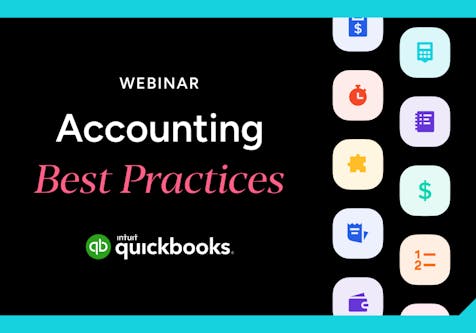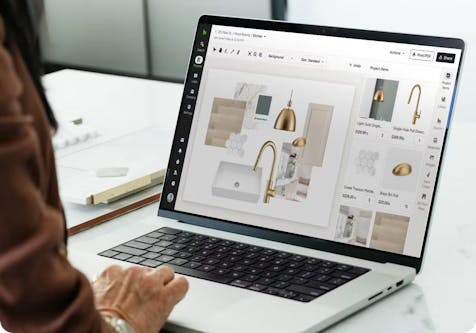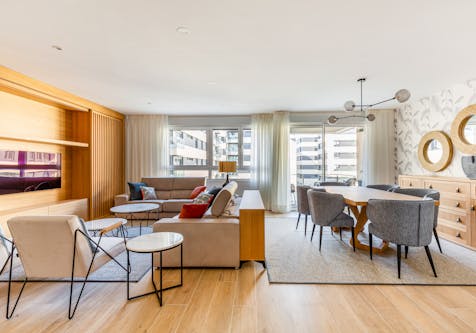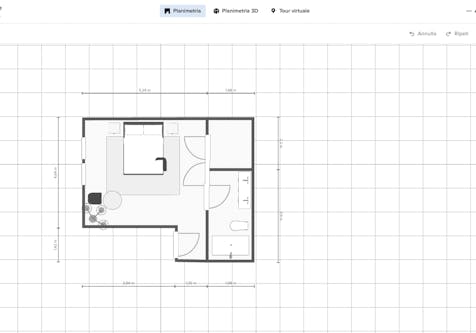Free Template: Interior Design Proposal & Guide
Find everything you need to start writing an interior design proposal from the experts at Houzz Pro. Use our free proposal template to get started today!

Is the thought of building an interior design proposal bringing you out in a cold sweat? We hear you. That’s why we’ve compiled this comprehensive guide on how to pitch your services in a clear and professional manner so you can create proposals that effectively win new business.
Read on and discover why a well-crafted interior design proposal is crucial for securing new clients and building your brand, whilst we also reveal the winning formula when it comes to writing a successful proposal. Click a link below to jump to the section you're interested in:
Download our Free Interior Design Proposal Template

Here's an Interior Design Proposal Template on Us!
Customize this Interior Design Proposal Template to nail your next client pitch.

To create a successful interior design business, you have to be prepared to do some selling - a skill not everyone is good at, especially when you are just starting out. What’s more you’re likely to be focusing all your energy on delivering triumphant projects and growing your brand awareness, rather than spending your valuable time writing lengthy proposals. That’s why a software program, like Houzz Pro, is ideal as it makes your design proposals a breeze, so you have more time for your design work.
Start a free trial of our interior design proposal software and discover a more efficient route to growing your business, then read on for expert advice on what to include in a winning template. Alternatively, if your business isn’t ready for software management tools just yet, download our free interior design proposal template using the same top tips below for your proposal creation.
Top tip: Invest some time in producing a good interior design template from the outset and you’ll be able to apply it repeatedly with only a few minimal changes needed, so you don’t have to create a new proposal from scratch every time.
What is an Interior Design Proposal?
So you’ve secured a potential lead thanks to your successful marketing campaign, captivating website and inspiring portfolio, but how do you turn this prospect into a paying client? The answer - by presenting a professional and transparent interior design proposal tailored to each prospect's needs, conveying what services you can provide your clients, how much the entire project will cost and a realistic time frame.
Top tip: The timing of your interior design proposal is crucial. Don’t make the mistake of sending your proposal out before you’ve had an introduction call or site visit to understand your client’s needs. This will not only appear desperate, but will also demonstrate your lack of time spent researching their unique project. Likewise, don’t leave a client waiting around for a proposal. Deliver it within the time frame you’ve promised or they might be encouraged to seek the services of another interior designer.
Why are Interior Design Proposals Important?
An interior design proposal is incredibly important for both the client and the designer. For the client, it’s an opportunity for them to understand what the project will entail, who is responsible for what tasks, how long the work will take, and how much it’s going to cost, as well as accepting their responsibilities in terms of decision-making and payment timelines.
As an interior designer, a proposal is safeguard against any potential disputes that may arise around the project scope and pricing, and allows you to state the terms of resolving such disputes, including when a contract can be terminated. Without a clear and concise interior design proposal, aspects of a project can be misinterpreted, leading to costly mistakes, not only for your pocket but possibly your reputation too.

What Should Be Included in an Interior Design Proposal Template?
From the goals of the project, to pricing of services, here we drill down on a proposal’s must-haves that will ultimately help win you work. It’s important to note that the order of these sections aren’t set in stone as you may want to tweak and curate your proposal template to suit each client and project.
- Contact Information - Your branding, logo and contact details should be the first thing the client sees at the top of the proposal so they know who it is from and can reach you easily. You should also personalise your proposal with the client’s name and contact details at the top too, so it feels unique to them and gives it more value.
- Goals - Set your client’s expectations of what the final project will look like by explicitly stating what will be accomplished during the work, and the responsibilities of yourself and the client, particularly if they are expected to complete anything themselves. By not clearly communicating the goals of the project, disagreements can arise.
- Price of Services - Despite being the trickiest part of the proposal to nail down, it’s one of the most fundamental, however, hitting a client with an intimidating total figure without clearly stating the breakdown, is likely to scare them off. The key is to explain the attribution of costs, so the client can understand how the total has been calculated, such as labour, time, and materials etc. For example, Houzz Pro interior design proposals allow you to add all the services and corresponding costs, including mark-ups, taxes, and other expenses. You choose which information to detail on the proposal. Greater financial transparency translates into more assured decision-making.
- Scope of Work - This is a crucial part of the proposal as it defines how you will execute the project to achieve the goals stated. You can go into detail about the order of the works, who is responsible for what aspects, how long each aspect is expected to take, and any key milestones during the project. If your proposal is also intended to serve as the contract, then this section can be continually referred back to as a mutual agreement about the work that’s being provided and the amount of time each stage is taking.
- Acceptance & Signature - Not a lengthy section but an important one - receiving the client’s sign off ensures they agree to your proposal. Consider using an online template that offers an e-signature tool, such as Houzz Pro’s interior design proposal template does, to make the process quicker and more efficient.

Optional Sections To Consider for Interior Design Proposals:
Consider tailoring your interior design proposal with these additional extras that could make it stand out from the crowd:
- Cover page - Presenting your proposal with an eye-catching cover page will grab client’s attention and give your concept statement an extra air of professionalism. You could include a stunning image of your work, alongside your logo, contact information and the client’s name to give it a personal feel.
- Summary - Some interior designers like to begin their proposals by summarizing their brand statement, design philosophy and what services they provide. This can be beneficial if the client has future projects in the offering. It can also be a nice way of introducing the team, so the client is familiar with who they will be meeting on site or speaking to on the phone.
- Portfolio Examples - Include images of your best work that delivers a similar concept to the proposed project, so the client has confidence you will provide what they are asking for. A small description to accompany each image about the brief and the outcome, will add more value to your work, as will a direct quote from that previous client if possible. This extra little detail on your proposal will demonstrate your expertise in your field and could push the lead over the line.
- Terms & Conditions - Include this section if you are intending the proposal to also serve as the contract, and use it as a means of stipulating important things like payment terms, extensions, and how the terms of the agreement are subject to change under certain conditions.

How Do You Write an Interior Design Proposal?
With the home improvement industry reporting record revenues, the competition for clients has never been hotter. Here’s our make-or-break tips to writing a winning interior design proposal that speaks directly to your client’s aspirations:
- Get to know your client - Delve into a client’s lifestyle and needs to fully understand their wants from the project. Schedule a call to discover more about their lives, and send them an insightful questionnaire to get the details. This way you can always put your best skills at the service of your clients, and tailor your proposal accordingly.
- Research solutions and offer curated design options - The design process can be overwhelming if the windows of opportunity are kept wide-open. Too many options can make the choice feel impossible. Presenting a few well-founded project solutions encourages the client to exercise their executive powers.
- Double check your proposal before sending it - Ensure your proposal includes all the elements listed above, and clearly offers a solution to your client’s problem. Then double check it! You don’t want your great interior design proposal to be derailed by a typo or a misplaced pic. Consistency and clarity in your communications builds trust.
- Provide clear next steps - Too often great proposals do not receive a green light simply because it is not clear for the client what exactly they can and should do next. Your contact information is not an immediate invitation to feedback.

Additional Tips for Interior Design Proposals
How long should an interior design proposal be?
Avoid sending clients lengthy proposals that relay too much detail or continue heaps of pages about yourself, your business and past projects. This is likely to discourage a client from engaging with you. Stick to the relevant information above and keep a focus on the client’s project. Reversely, your proposal shouldn’t be too short either as this might indicate you don’t have the relevant experience or lack interest in the work. Following a template, such as the one provided by Houzz Pro, will give you a good indication of how long a successful proposal should be.
How is an interior design proposal different from an interior design contract?
In short, a proposal is your sales pitch, while a contract is the terms and conditions of the project, including things like termination clauses, liability clauses, and details about late payments. Despite them serving different purposes and often being presented in two separate documents, it is possible to stitch them together. If presenting two separate documents, ensure your proposal includes a line at the bottom that reads ‘Subject to the agreement of the Terms and Conditions attached’, and send the contract at the same time as the proposal. For more useful information, read our comprehensive guide on How to Write an Interior Design Contract (with template).
Conclusion
Be under no illusions that preparing an interior design proposal is quick or easy. It takes time, commitment and attention to detail. However, with a good template, like the one offered by Houzz Pro, you’ll be able to save time by creating a proposal in a few simple steps. Start a free trial of our interior design software to see for yourself. And, of course, the more you hone your skills at proposal writing, the more efficient you’ll become and the more impressive your proposals will look, winning you bigger and better clients.
Once a client approves your proposal, you’ll need to start drafting a schedule to successfully execute the project. To continue learning, read our next article on How To Build An Interior Design Schedule (With a Template) to help you stay organized and on top of your project(s).

Want advice delivered to your inbox?
Unlock industry insights and updates for contractors and design pros
By signing up, I agree to the Houzz Terms of Use and Privacy Policy and that Houzz may use my information to contact me about relevant content, products, and services.








Join the conversation by commenting or asking a question below. The Houzz team reads every single comment, and we’ll get back to you by email if you need us!